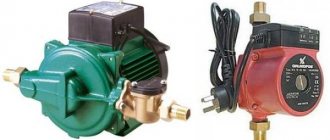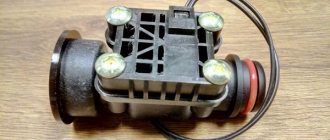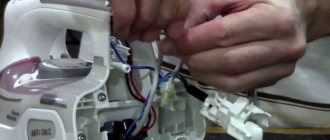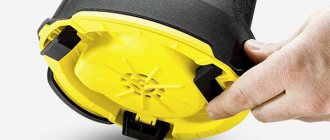Any devices or systems that work with water will function without problems if they are equipped with electronic or electrical devices that prevent equipment failures and breakdowns. The main task for water supply and heating systems is to ensure their uninterrupted operation. Help in this case is provided by pumping equipment, which is especially sensitive to the lack of liquid in the water supply. To prevent possible emergency situations, owners of autonomous systems use a water flow sensor, its second name is a flow switch. This small device plays an important role, so it is necessary for almost any system in which a pump operates. You need to know in advance what a flow sensor is and how the device operates. “Close acquaintance” with the devices will make it possible to select and correctly configure the device.
Purpose of the water flow sensor
No one will be happy about the failure of the main “driving force” of any autonomous system in which water “works.” To ensure efficient, trouble-free operation of pumping equipment, several additional devices are used that monitor and prevent possible failures and failure of the pump.
Among them are a temperature sensor, a pressure switch and a water flow sensor. The hero of this article is the last of the “trio” of devices. First of all, it, like other auxiliary devices, provides reliable protection against breakdowns. The water flow sensor has other names - dry running sensor (protection), flow switch, pump controller or control unit.
The most undesirable situation for autonomous heating and water supply systems is starting pumping equipment at a time when there is no water in the pipeline. Such incorrect operation is called idle operation, or “dry running”. Since the liquid helps cool the unit and serves as a kind of lubricant for the device, without it an accident is inevitable.
For example, even a short period of time in dry running mode can lead to a decrease in performance. If the problem is not addressed in time, then in the future the owners will be faced with deformation of structural parts, overheating of the pump and its subsequent breakdown - jamming and failure of the engine.
When is a flow switch necessary?
Such serious consequences of living without water await any unit; they do not depend on the type of operating devices. Overheating and failure equally threaten both surface and deep-water equipment. There are several reasons for dry running. “Provocateurs” include:
- low pressure in the system in the absence of monitoring devices (pressure switches);
- violation of the integrity of any section of the pipeline (suction pipe);
- debris that has accumulated in the water pumping pipe;
- reducing the amount of water in the source;
- incorrect choice of device power;
- incorrect installation.
- the system uses a low-power pump, and the well has a high flow rate;
- while the pump is operating, the technician is located next to the equipment, so he will be able to turn off the unit if the water level suddenly drops below normal.
An automatic water flow sensor is designed to prevent such situations and protect pumping equipment from insufficient liquid. This simple design measures flow parameters, controls them, and maintains them at the same level. Water flow switches have small dimensions and the same reasonable price. They are easy to install, but allow you to protect equipment from breakdowns and premature wear, increase its service life, and also reduce energy consumption.
The benefits of the device are undeniable, but do such relays have any disadvantages? Unfortunately, shortcomings are easily found in any design. The category of weak points of water flow sensors includes weakening of the springs over time, which will require the purchase of a new device. As they say, such devices generally break down quite often, and repairing complex models can be expensive.
Is a sensor always needed?
When can you do without a flow switch? There are two options when this device is not required. There is no need for installation if:
In all other cases, the installation of a device that keeps the fluid flow under “vigilant” control is mandatory.
Where are they used?
Screw pump: principle of operation, scope and design features
Flow sensors are used in devices where control of the water supply system to an apartment or private house is necessary. By installing this type of equipment on a gas boiler, you can significantly reduce your monthly payment, and the heat generator will also become much safer to use.
For gas boilers
There is a water flow regulator in all boilers (Buderus and other models). Thanks to the device, the heat generator can work as a device for heating a home and heating water.
The gas boiler water pressure sensor is mounted on the pipeline. Once installed, it begins to respond to flow as soon as the hot tap is opened.
The regulator transmits a signal to a special board installed inside the boiler. After this, the circulation pump automatically starts and the pressure in the gas injectors decreases. As a result, the water circulation valve closes. After this, the water heating nozzles turn on, and the liquid begins to warm up in the heat exchanger. After closing the valve, the mounted sensor for the gas boiler records this action and transmits the corresponding signal to the board.
For pumps
In many private houses, an autonomous water supply system is installed. This is necessary if there is often low pressure on the site and the owner wants his yard to be independent of the centralized water supply. The equipment is installed so that the water pressure in the house always remains at a high level.
The system includes:
- special pump;
- a tank where water is poured;
- control system.
You can connect various household appliances to the pump, for example, dishwashers or washing machines. In this case, the regulator is necessary for timely activation of the pump, ensuring a stable water supply.
And it doesn’t matter whether the wash has started, the tap is open in the kitchen, or water is draining from the toilet tank - the regulator performs the same functions for any type of household equipment connected to the system.
Also, the owners of the living space in question often connect the sensor in question to automatic watering in the country or in a private house. Here the device not only performs the opening function, it regulates the amount of water that should be consumed at a time.
This function is very useful if dosed watering is used so as not to over-moisten the soil. For stable operation, the flow regulator is mounted to the central pipeline, and it transmits all information to the system control panel.
Flow switch: device and principle of operation
The main job of the water flow sensor is to constantly monitor and turn off the pumping station if the device detects that the flow power has decreased. When the readings return to normal, he turns on the equipment. If we talk about the most popular designs, they are petal relays, but there are other types of devices.
Petal water flow sensors
These are classic “defenders”. The design of the paddle sensor is relatively simple. Such devices include several important elements:
After filling the chamber with liquid, the flow, or rather its force, begins to affect the valve, which moves relative to the axis. The petal compresses the spring. Thanks to the magnet located on the other side of the valve, the switch contacts close, turning on the pumping equipment.
When the flow force drops to zero, the reverse process occurs: the valve spring expands, the petal with the magnet returns to its original position. The switch also returns to its previous position and the pump stops.
Some devices do not have a second, return magnet. It is replaced by ordinary springs. The main disadvantage of such flow sensors is less stability, because they are more affected by even small pressure surges.
The main advantage of a petal relay is its simplicity and unpretentious design, which guarantees its uninterrupted operation. Other advantages are the almost instantaneous operation of the device, the absence of delays between them, and the absence of a decrease in fluid supply pressure.
Other types of flow switches
There are other varieties, but these designs are used much less frequently, and for various reasons.
Press control
This is the name of the water flow sensor, which is combined with a pressure switch. This device will turn on the equipment only if the liquid level in the chamber reaches a certain level. It can be adjusted; values within 1-2 bar are more often used. The equipment stops within 5-10 seconds.
These models are used to protect pumping stations. In this case, they are installed on the outlet pipe of the pump. There is a disadvantage to combined devices; it concerns surface-type pumps. If press control is installed on such equipment, then before each start it will have to be manually filled with water. Additional check valves will help solve the problem, but they are not the best solution.
Flow thermostat
This water flow sensor has the most complex design, and therefore the same high price. The principle of operation of the device is based on comparing the temperatures of the fluid flow and the value to which the device’s sensors are configured. The temperature of the sensors is slightly higher than that of the liquid; this condition is met due to their constant heating by electricity.
When the flow of colder water cools the sensors, this change is immediately recorded by the microswitch. The temperature difference becomes a signal that triggers the pumping equipment. If the water flow stops, the temperature of the sensors rises to a normal level, so the contacts of the electrical network and the device open. As a rule, thermal flow switches are equipped with pump models in the high price category.
Float switch or water level switch
These designs can rightfully be classified as “couldn’t be simpler.” This is the simplest, utilitarian option, which is familiar to everyone who has once observed the operation of a float mechanism, for example, in a toilet cistern. Such a “float” switch is installed inside the source, approximately 200-250 mm higher than the pump is located.
Its operating principle is not to control the operation of equipment. The relay monitors the water level. As soon as it drops below the place where the float switch is located, it also drops and turns off the pump. The disadvantage of the models is that they cannot be used in narrow, deep wells. The reason is the difficulty of adjustment, which consists of changing the length of the cable to which the device is suspended. For a well, on the contrary, this “float” is ideal.
Design features
The main tasks that water flow control sensors installed in domestic pipelines solve are to turn off pumping equipment at a time when there is no liquid in the system or its flow pressure exceeds the standard value, and turn it on again when the pressure drops. An effective solution to these important problems is provided by the sensor design, which consists of the following elements:
- a pipe through which water enters the sensor;
- a membrane that makes up one of the walls of the inner chamber of the sensor;
- a reed switch that provides closing and opening of the pump power supply circuit;
- two springs of different diameters (the degree of their compression regulates the pressure of the fluid flow, at which the water flow switch for the pump will operate).
Main components of an industrial flow sensor
The device of the above-described design works as follows:
- Entering the inner chamber of the sensor, the water flow puts pressure on the membrane, displacing it.
- The magnetic element fixed on the back side of the membrane, when it is displaced, approaches the reed switch, which leads to the closure of its contacts and the pump being turned on.
- If the pressure of the water flow passing through the sensor drops, the membrane returns to its original position, the magnet moves away from the switch, its contacts open, and accordingly, the pumping unit is turned off.
The operating principle of a flow sensor based on a permanent magnet and a reed switch
Sensors that monitor water flow are installed quite simply in pipeline systems for various purposes. The main thing is to choose the right device, paying attention to its operating parameters and characteristics of the pumping equipment.
How to choose a water flow sensor?
When choosing any device, first get acquainted with its technical characteristics. Such relays are no exception. Before purchasing these devices, you need to pay attention to several parameters. This:
Another important factor is the material from which the device is made. The best options would be structures made of stainless steel, aluminum or brass. By purchasing such a water flow switch, you will not have to worry about frequent force majeure in water supply systems - water hammer. The second point that needs to be considered separately is the compliance of the operating pressure of the power sensor of the pumping equipment. The parameters of the water flow circulating in the system depend on this indicator.
If you decide to use a thermal flow switch, then you need to select a device based on operating temperatures. For example, for heating and hot water supply systems this parameter should be quite high. For cold water, a device whose temperature range ends at 60° will be sufficient.
Main characteristics
When choosing water flow sensors to equip a pipeline system, the following parameters must be taken into account:
- material for manufacturing the body and internal elements;
- operating pressure for which the sensor is designed;
- temperature range of the liquid to control the flow of which the device will be used;
- protection class and requirements for operating conditions;
- diameter of mounting holes and thread parameters in them.
Each of the above parameters affects the operational features of water flow sensors, so it is worth considering them in more detail.
The reliability of such a device, its ability to withstand loads arising during operation, as well as its durability depend on the material from which the sensor body and its internal parts are made. When choosing a fluid flow sensor, it is better to give preference to models for the manufacture of which various metals were used - stainless steel, brass or aluminum. During operation, both the body of the flow sensor and its internal elements experience significant pressure from the liquid passing through it. Only durable materials can withstand such a load for a long time. In addition, phenomena such as water hammer are common in pipelines, the consequences of which can quickly damage the sensor if inappropriate materials were used for its manufacture.
Flow sensor with brass body
The operating pressure at which the fluid flow sensor can operate correlates with the power of the pump used, so special attention should be paid to this parameter. In addition, this parameter also determines what characteristics the liquid flow transported through the pipeline will have. Those models of water flow sensors, which are designed with two springs, can control the operation of the pump at the lower and upper pressure levels. It is better to give preference to devices of this particular type.
The temperature of the liquid for which the sensor is designed has a direct impact on the systems in which it can be used. Naturally, when choosing such a sensor to equip a heating or hot water supply system, you should pay attention only to those models that can work with water heated to a high temperature. For pipelines through which cold water is transported, flow sensors are used, designed to work with liquids having a temperature of 60–80°.
Boost pump with flow sensor
How to install and configure a water flow sensor?
Often, a flow switch is already included in the equipment, but sometimes it becomes necessary to install a separate device. It is mounted on horizontal sections of the water supply system. Care must be taken to ensure that the valve axis is positioned strictly vertically.
Installing a water flow switch
The device is mounted to the water supply using a threaded coupling. As a rule, a special nest is intended for it. If a hole is not provided, then one is created. A brass tee is installed on the site, to which you can additionally connect another important device - a pressure switch. The thread is sealed with FUM tape or flax. Additionally, it is recommended to treat the connection with a sealant.
When installing the flow switch, focus on the arrow, which is shown on the body of the device. This direction, indicating the fluid flow, must coincide with the real one. If the liquid in the system is of poor quality, then another addition is needed - filters for water purification. They are installed before the flow sensor. The minimum distance between the flow switch and the pipeline is 55 mm.
The last operation at the final stage of installation is connecting the device to the electrical network. The operation consists of several simple steps:
After completing this stage, the operation of the relay is checked. If the pressure gauge readings change and the pump stops when the limit value is passed, then we can assume that the task is completed.
Adjusting the device
The device has special bolts for adjustment. Tightening or loosening them makes it possible to change (increase, decrease) the compression force of the springs. Using this operation, you can set the required pressure level, upon reaching which the device will turn on or off the pumping equipment.
As a rule, sensors do not require additional actions from owners: they are already perfectly adjusted at the factory. However, in exceptional cases such a procedure may still be required. The setup goes like this:
- First, liquid is drained from the system until the pressure drops to zero. Then the pumping unit is turned on again, but the water is released slowly.
- Wait until the sensor turns off the pump. At the same moment, the pressure readings are remembered. Then they begin to drain the liquid again until the pump starts. And these pressure indicators are also remembered.
- After this, the sensor is opened and, using the adjusting bolts, the maximum and minimum pressure limits are adjusted in turn, changing the compression force of the springs. For a large part, set the minimum compression level, for a small part - the maximum.
After the adjustment is completed, the operation of the equipment is checked again. First, the pipeline is filled with water, then it is drained. If the values require adjustment, the setting is repeated. When operating equipment, water flow sensors are checked annually. If necessary, the parameters are changed.
Popular models
A wide range is a blessing, but not always, because abundance can become “evil”, only making it difficult to choose. Therefore, we need to briefly talk about the models that are considered one of the most popular and in demand.
- Lowara Genyo 8A. This device is produced by the Polish company LOWARA, which produces devices “specializing” in equipment protection and pump control. This sensor is intended for installation in domestic conditions. Its operating temperature range is 5-60°, electricity consumption is 2.4 kW.
- WWQ-RD (RD-1, RD-2). This is a line of fairly high-quality, effective, but inexpensive devices. The devices protect against idle operation; the models are equipped with a built-in check valve.
- Water robot Turbi. This is a pump control unit from the Russian manufacturer UNIPUMP. The device is capable of working with any type of pumping equipment. Water temperature range - from 5 to 35°, power - up to 1.5 kW.
- Vortex - pump controller, or dry running sensor. This device also has a built-in check valve. The maximum water temperature is 55°, power is 1.2 kW.
Other companies producing popular water flow sensors: AquamotoR, Belamos, ELITECH, Eterna, Grundfos, PUMPMAN, Tim, UNIPUMP.
The water flow sensor controls and automates the operation of the main element of the autonomous system, so this element will not be superfluous in any case. On the contrary, its installation will extend the life of the pump, since the relay is an almost one hundred percent guarantee of the absence of all serious installation failures.
The protective relay is a kind of reinsurance, but the design will pay for itself in any case. Especially when you consider the cost of a failed pump. But the decision always remains with the owners. The following video will show you how to install a simple but necessary petal device:
Was this article helpful? We want to improve. Thanks for your opinion!
If you liked the article, please share it
Previously on the topic:
Share











